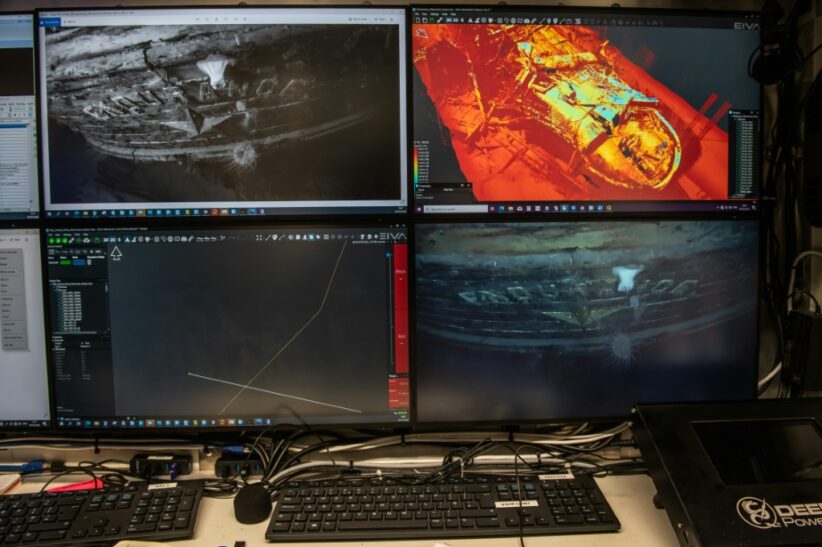Explorers have found one of the most famous shipwrecks in history, Ernest Shackleton’s Endurance, deep in the icy sea off Antarctica more than a century after it sank, they announced Wednesday.
Endurance was discovered at a depth of 3,008 metres (9,869 feet) in the Weddell Sea, about six kilometres (four miles) from where it was slowly crushed by pack ice in 1915.
Shackleton went down in expeditionary legend through the epic escape he and his 27 companions then made, on foot and in boats.
“We are overwhelmed by our good fortune in having located and captured images of Endurance,” said Mensun Bound, the expedition’s director of exploration.
“This is by far the finest wooden shipwreck I have ever seen. It is upright, well proud of the seabed, intact, and in a brilliant state of preservation. You can even see ‘Endurance’ arced across the stern,” he said in a statement.
The expedition, organised by the Falklands Maritime Heritage Trust, left Cape Town on February 5 with a South African icebreaker, hoping to find the Endurance before the end of the Southern Hemisphere summer.
As part of Shackleton’s Imperial Trans-Antarctic Expedition between 1914 and 1917, Endurance’s crew was meant to make the first land crossing of Antarctica.
But their three-masted sailship fell victim to the tumultuous Weddell Sea.
Just east of the Larsen ice shelves on the Antarctic peninsula, the timber vessel became ensnared in pack ice in January 1915.
It was progressively crushed and then sank 10 months later.
– ‘Worst sea in world’ –
The crew first camped on the sea ice, drifting northwards until the ice cracked open, and then took to lifeboats.
They sailed first to Elephant Island, a bleak and treeless place where most of the men were dropped off and set up a camp.
Using just a sextant for navigation, Shackleton then took five others in the strongest and most seaworthy boat on a 1,300-kilometre (800-mile) voyage to South Georgia, a British colony where there was a whaling station.
Defying mountainous seas and freezing temperatures, the 17-day trek aboard the 6.9-metre (22.4-foot) open boat is often considered one of the most remarkable achievements in maritime history.
All 28 expedition members survived.
The current-day explorers used underwater drones to find and film the shipwreck in the merciless Weddell Sea. Its swirling current sustains a mass of thick sea ice that can challenge even modern ice breakers.
Shackleton himself described the site of the sinking as “the worst portion of the worst sea in the world”.
The region remains one of the most difficult parts of the ocean to navigate.
“This has been the most complex subsea project ever undertaken,” said Nico Vincent, the mission’s subsea project manager.
– ‘Like the Titanic’ –
The underwater drones produced stunningly clear images of the 44-metre (144-foot) -long ship.
Amazingly, the helm has remained intact after more than a century underwater, with gear piled against the taffrail as if Shackleton’s crew had only just left it.
The ship’s timbers, though damaged from the crush of ice that sank in, still hold together. A mast had snapped into two across the deck, and portholes hinted at what secrets may still lurk inside.
Sea anemones, sponges and other small ocean life forms made their homes on the wreckage, but did not appear to have damaged it.
“It’s quite remarkable just to see the pictures of that ship on the sea floor, equivalent to the discovery of the Titanic,” said Adrian Glover, a deep-sea biologist at Britain’s Natural History Museum.
“It’s not a forgiving place, as Shackleton and others found out,” he told AFP. “The sea ice there can get very thick, very quickly, and crush a ship, or at least halt its progress.”
An earlier mission in 2019 had failed to find the Endurance, noted South Africa’s environment ministry, which owns the icebreaker.
Under international law, the wreck is protected as a historic site. Explorers were allowed to film and scan the ship, but not to touch it at all — meaning no artefacts may be returned to the surface.
The team used underwater search drones known as Sabertooths, built by Saab, which dove beneath the ice into the farthest depths of the Weddell Sea.
During the mission, scientists also researched climate change, documenting ice drifts and weather patterns.
Stefanie Arndt, a sea ice researcher from Germany’s Alfred Wegener Institut, said on Twitter that she was returning with 630 ice and snow samples. “An incredible number,” she said.
The team now must make the 11-day journey back to port in Cape Town.









